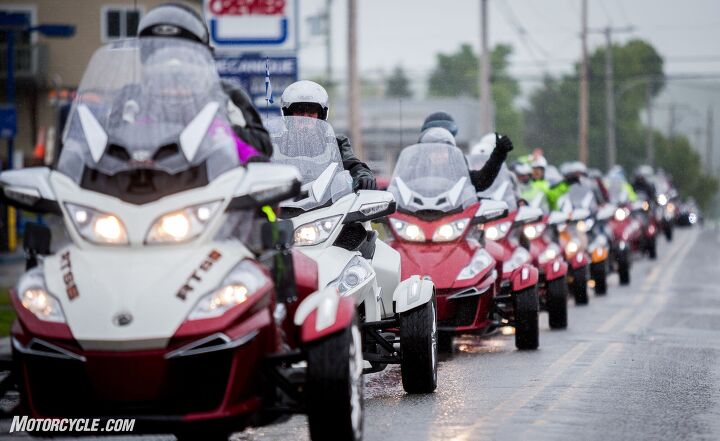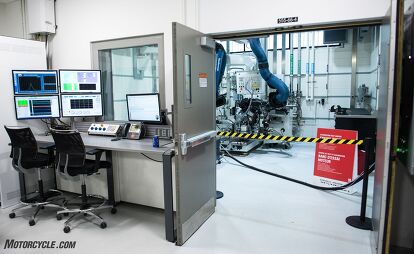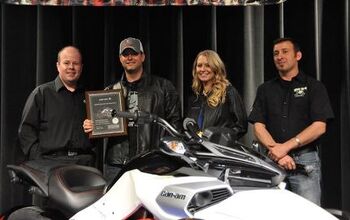Can-Am Spyder 10th Anniversary Homecoming

BRP invites the Spyder faithful to celebrate 10 years of production
Anniversaries and birthdays that end in 0 tend to garner more attention. So, why should the 10th anniversary of Can-Am Spyder production be any different? Not surprisingly, Can-Am/BRP invited Spyder owners to join them in Valcourt, Quebec, the place where the Spyder began, for a birthday bash. As with most rallies, organized and self-guided rides were planned, ample amounts of food was available, music was heard in multiple venues, and awards were given for custom machines. However, Can-Am went even further by introducing three anniversary Spyder models and opening its factory, design center, and R&D center for attendees to tour. Not many manufacturers would do that for any occasion.
2016 Can-Am Spyder F3-T First Ride Review
2017 Can-Am Spyder F3-S, Now With Drift Mode!
BRP Releases 10th Anniversary Special Edition Can-Am Spyder Models
Valcourt appears to the visitor to be a sleepy town of 2,349 people (according to 2011 Canadian census statistics) located in a mostly rural section of Quebec. The scenery is bucolic – even from the inside of a drizzle misted visor – in a way that melts away big city stress. The roads meander and are perfect for riding. Since Can-Am/BRP employs approximately 2,700 people in its Valcourt facilities, the company plays an outsized role in the community. Now, mix in 3,000 registered participants in the Can-Am Spyder Homecoming 2017, and you’ve got a recipe for what is essentially a huge family reunion. While the weather may not have been as nice as everyone hoped, the rain didn’t seem to dampen anyone’s spirits.
Opening on Friday morning June 2nd with a rainy parade into Valcourt greeted by Spyder fans and BRP employees, Spyder riders showed themselves to be a hearty lot – with smiles as big as their rain gear was bright. No one really seemed bothered by the weather. Although the tented areas were crowded, they were full of laughter and riding stories being swapped. Friday night’s events included a surprisingly good, all-BRP employee rock band and speeches by key BRP players (notably Jose Boisjoli (BRP President and CEO), Denys Lapointe (BRP Senior Vice President Design & Innovation), and Josee Perreault (BRP Senior Vice-President, Spyder Business)) – all of which culminated in the introduction of three limited-edition (based on pre-orders), 10th Anniversary Spyders. The crush of humanity trying to get close to the new models was something akin to a rock concert as crowds rush the stage.
Saturday’s weather improved and the Spyder family was out for more rides and facility tours before assembling at the nearby city of Drummondville for a four-hour celebration of the Spyder with dinner, awards, more speeches, and a concert. Spyder riders know how to have a good time – and they are willing to travel, too. Riders from Australia, Japan, and Russia were in attendance. The people whose travel plans didn’t involve airplanes rode from all points in Canada and the U.S. These folks are dedicated, and by Sunday, they were back on the road heading home.
Read on to find out what we saw in Valcourt and what we learned about Spyder riders over the weekend.
BRP Factory
Of the facilities BRP had open for tours, the Spyder assembly line was perhaps the least impressive for two reasons. First, Spyder production is seasonal, and the factory is currently producing the snowmobiles for the winter buying season. The second reason was that much of the facility was under construction for increased capacity and modernization. Visitors who tour the factory in a year or so will see a completely different facility – one where the self-propelled vehicle lifts are guided from station-to-station via magnetic stripes on the floor rather than the current metal rails. Additionally, the assembly workers will have their part selection and assembly instructions guided by computer much in the way the Harley-Davidson Pilgrim Road Powertrain Plant is. The goal, as always, is to produce Spyders more efficiently and with fewer assembly errors.
Touring Harley-Davidson’s Pilgrim Road Powertrain Operations Plant
However, one assembly line was set up with Spyders in various stages of assembly at stations along the line. At the stations, technicians were present to answer owner questions and explain the assembly process. If you’ve never visited a factory like this, you’ve really missed out.
Design & Innovation Center
Inside the Design Center’s main atrium, two work stations were set up with designers demonstrating how they use the tools to sketch design ideas and render them into 3-D imagery. A few doors down, a sculptor worked on a full-size clay rendering of a side-by-side utility vehicle. This model can be used to refine the lines of bodywork in the 3-D world instead of on a 2-dimensional monitor. Once the designers are happy with the model, its dimensions are scanned into the workstations for further manipulation as the vehicle’s design progresses.
Product Development Center
To enter the working space of the BRP Product Development Center, visitors must walk down a hall lined with all the patents the company has acquired through its history. While they range over the Spyder, snowmobile, and side-by-side categories, the effect is nonetheless impressive, and exploring the details on the plaques is entertaining.
The Product Development Center is where the engineers break things. Yes, there are dyno rooms where the engines are developed and tested – a process that is pretty cool to watch through the soundproof windows as the graphs go up and down on the monitors. Then there is the roller dyno in a semi-anechoic room for use in tracking sound levels around the vehicle. The roller dyno is also used for determining the exhaust emissions for vehicle certification.
The real fun for visitors takes place in the stress-testing labs. Here. whole vehicles or just single components are strapped to futuristic instruments of torture. In the case of whole vehicles, machines can simulate the effects of traveling over extremely bumpy roads for thousands of miles to see what – if any – effect it will have on the chassis or suspension components. Unlike tests that require people to ride the machines, these tests can be run around the clock without stopping for as long as necessary. Other tests include calculating the failure rate of switches by repeatedly toggling them or using brute force to see how much components can stand before they frag. Fun stuff.
Rally attendees who visited the Product Development Center were also lucky enough to see a display of Spyder F3 prototypes, starting with the first test mule and progressing to the updates resulting in the current generation F3. From the cobby, hand-built nature of the mule to the polished almost final product, the process is a combination of both large and minute changes that rewards close investigation by visitors.
Museum of Ingenuity
The facade of Joseph-Armand Bombardier’s garage stands as part of the Museum of Ingenuity’s exterior, and although the museum itself isn’t ostentatiously large, it shows the history of BRP and how far its products reach. Most Spyder fans are aware that BRP manufactures Ski-Doo snowmobiles and Sea-Doo personal watercraft, but part of Joseph-Armand Bombardier’s legacy is also the manufacture of jets and subway cars by Bombardier (a separate entity from BRP which spun off in 2003).
Why would a company want to take the extraordinary step of allowing the public into its most secret facilities? Think of the monumental preparation that must take place to make sure that nothing relating to future products would be visible to the curious eyes of the attendees. During a press briefing BRP President and CEO, Jose Boisjoli, explained the company’s reasoning: “We are trying to create a community and trying to engage them. We believe that by showing where we come from – the Design & Innovation Center, the R&D, the factory, and the museum – it’s a way to engage them and show them that the community will continue to grow.”
“They are our best brand ambassadors,” added Josee Perreault, “and we really need them. For us, it is our mission to put more butts on seats, and we can’t do it without them.”
In fact, an advertising campaign supporting this statement was debuted for the rally attendees at the final event. Titled “I’m a Ryder,” the advertisements feature real Spyder owners as a means of attracting more people. The average Spyder owner is 62 years old, and more than 30% of the owners are women. Unlike some other powersports companies, which are pursuing younger participants, BRP sees this older demographic as largely untapped and is actively seeking them out. According to Perreault, two factors are limiting the growth of Spyder ownership. The first is making people aware of Spyders since many of them do not come from a motorsports background. The second is confusing licensing requirements that vary from state-to-state which BRP would like to have clarified.
Although BRP keeps its sales numbers close to the chest, the company will state that it has sold more than 100,000 Spyders worldwide. When you consider that 3,000 Spyder owners attended the Homecoming in Valcourt, that means 3%of Spyder owners were in attendance. This is a pretty impressive percentage, and the fact that BRP is looking leverage that passion to grow a market that it created looks to be a smart move. We’ll keep watching to see what BRP has up its sleeve with the Can-Am Spyder.

Like most of the best happenings in his life, Evans stumbled into his motojournalism career. While on his way to a planned life in academia, he applied for a job at a motorcycle magazine, thinking he’d get the opportunity to write some freelance articles. Instead, he was offered a full-time job in which he discovered he could actually get paid to ride other people’s motorcycles – and he’s never looked back. Over the 25 years he’s been in the motorcycle industry, Evans has written two books, 101 Sportbike Performance Projects and How to Modify Your Metric Cruiser, and has ridden just about every production motorcycle manufactured. Evans has a deep love of motorcycles and believes they are a force for good in the world.
More by Evans Brasfield













































Comments
Join the conversation
Having choices is very good. I have no joint cartilage because of an abnormality in the collagen component in my joint cartilage. My immune system destroyed all of it by the time I was 14. I started out riding dirt bikes and junior motocross at the age of 9. It got to the point I couldn't even get my legs apart enough to straddle the seat. My entire spine and both hips fused. My dream was to ride a motorcycle again, but the prospects were zero to none that I'd be able to do it. In the late 70s after 12 years on crutches, I learned about hip replacement surgeries. I had to keep my dream to myself, as I was labeled a total idiot for wanting to ride a motorcycle. I did it anyway, 7-8 hours for each replacement back then. Atrophied muscles meant torture, I mean physical therapy, 3 times a week for years. The first hip replacement, done in 1980, failed and had to be re-done. In May 1983 after 3 total hip replacements, I got my first street bike. No celebrations, no applause, no recognition for a huge goal accomplished. I didn't go through all of it for that, I wanted to ride. And ride. Never looked back, put 38,000 miles on that bike, an early 80s KZ250 in my first two years. In the late 90s, I started to look at options so I could keep riding, as the deterioration was a natural progression of this condition. No amount of surgeries can stop it. I looked at three wheels, sidecars, trike conversions. I ended up with a Ural Tourist, then a Burgman 400. The Spyder had just came out, but I already had the other bikes. Just a year or two earlier, it would have been the machine in my garage. Sure, frozen joints, atrophied muscles and I want to ride a motorcycle? What a fool. Didn't I know that motorcycles make people disabled or dead? Yes, but it turned out that being able to ride again saved my life. Having options like the Spyder can keep someone like me, with a dream, riding as long as possible. Thanks for the great article!
My 2013 RT Limited put me back in the wind, after a lot of years being unable to ride because of physical issues. I personally don't care if someone doesn't see Spyders as motorcycles. I bought mine for my enjoyment, not to please someone locked into a "it has to have two-wheels" mentality. To date, my longest trip was from the West Virginia Eastern Panhandle to Tucson, AZ, and back, by different routes. 5,391 miles over 19 days of riding. Some days were short - some were 11 or 12 hours - but all were great! Thanks, BRP, for marketing such a great solution for those of us whole lived long enough to get old!